Amphibians, particularly frogs, hold a unique position in the biodiversity tapestry. Studies from the Journal of Herpetology estimate that there are over 7,000 species of frogs worldwide. These creatures, often associated with rain songs and monsoon stories, are crucial indicators of an ecosystem’s health. Their permeable skin makes them vulnerable to environmental changes, and hence, a decline in their numbers can indicate larger ecological issues at play.
So, what are the rarest frogs in the world? The answer lies not just in their dwindling numbers but also in their unique attributes and habitats. Top among these are species like the Isthmohyla rivularis, the Archey’s Frog, and the La Loma Treefrog – each with a tale of survival, wonder, and often, a dance with extinction.
This article unfolds the stories of these elusive amphibians. From the heart of the Amazon to the highlands of Sumatra, we’ll journey across continents, uncovering tales of resilience, marveling at nature’s wonders, and understanding the pressing need to protect them.
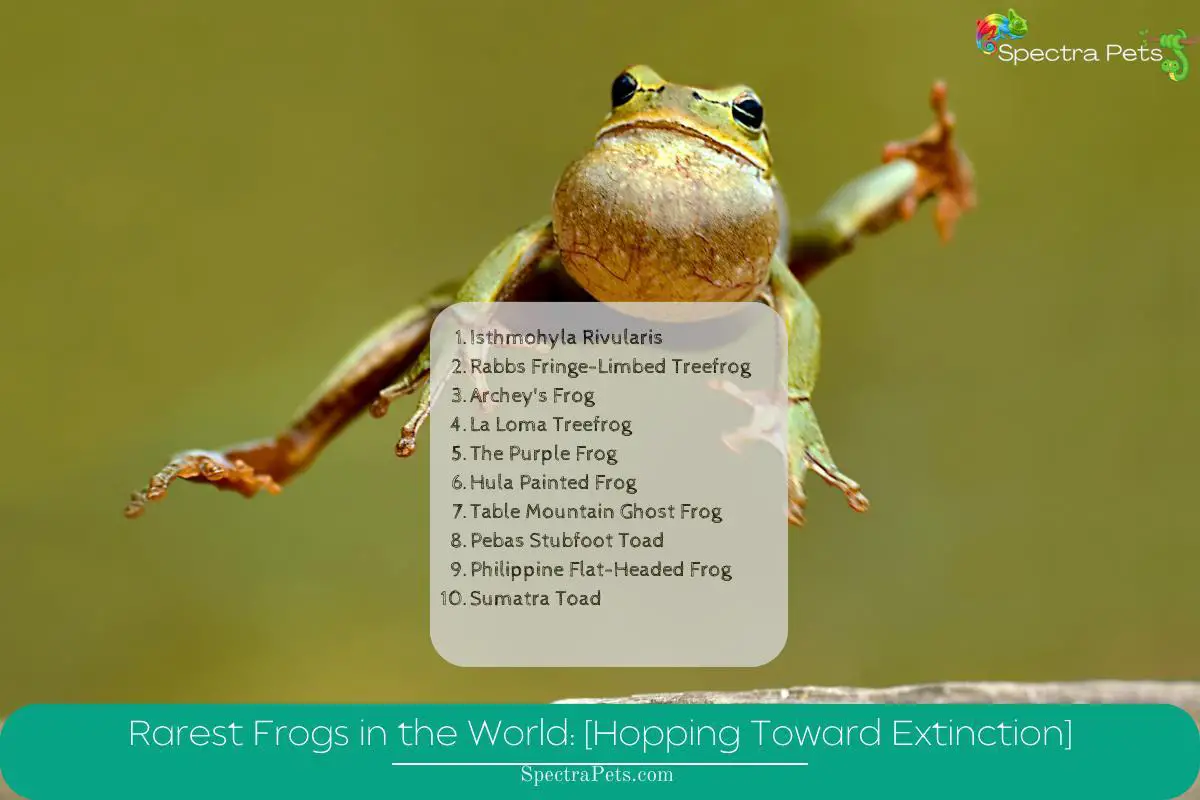
1. Isthmohyla Rivularis: Rediscovered Treasure
The cloud forests of Costa Rica and Panama have long concealed many of nature’s secrets, and among them is the delicate Isthmohyla rivularis. The common name American Cinchona Plantation treefrog has been suggested for it.
Species Profile:
- Scientific Name: Isthmohyla rivularis
- Lifespan: Estimated 5-8 years
- Average Length: 1 to 2 inches
- Origin: Cloud forests of Costa Rica and Panama
- Special Characteristics:
- Light green skin with yellow spots and a transparent underbelly
- Nocturnal habits, often found near streams
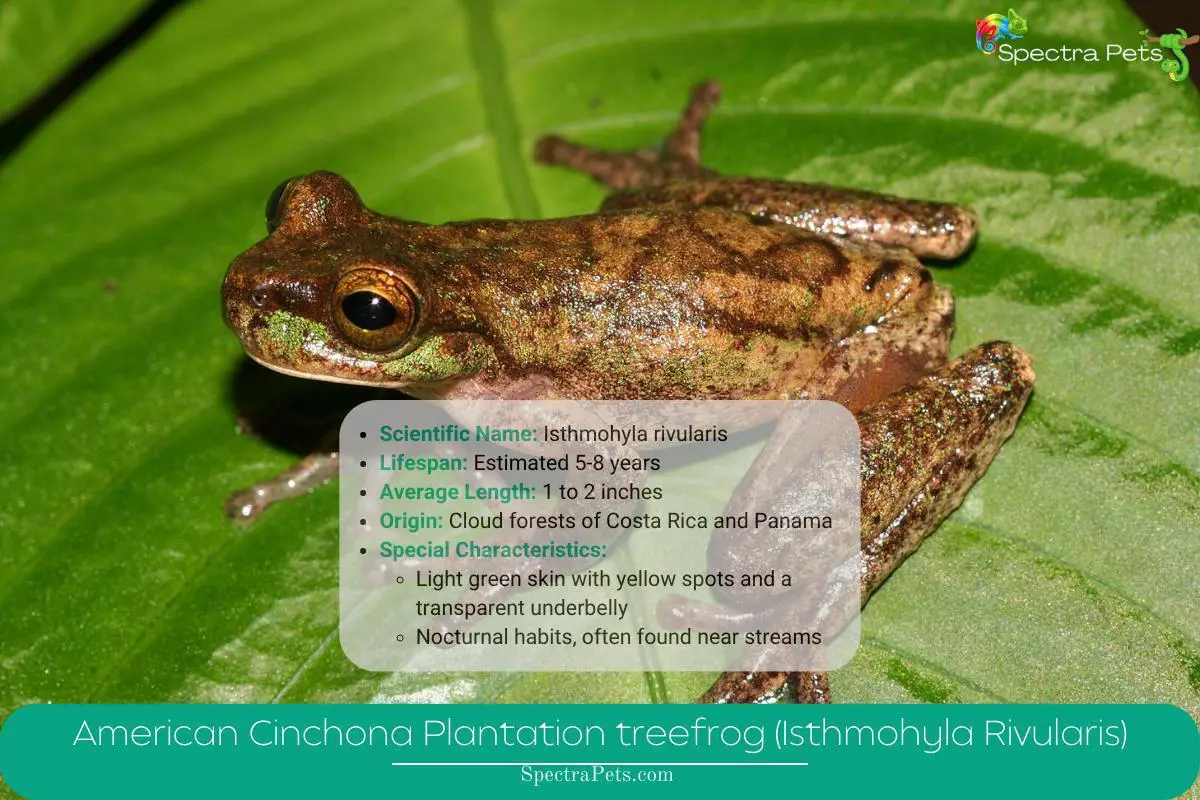
Often merely known by its scientific name due to its elusive nature, this frog’s light green skin serves as an almost magical camouflage amidst the dew-laden foliage. Its transparent underbelly, revealing its internal organs, adds a touch of wonder to its already mesmerizing appearance.
By day, it remains unseen, sheltered from prying eyes. But as dusk sets in and the world succumbs to twilight, the nocturnal habits of Isthmohyla rivularis come alive. The nearby streams resonate with its mating calls, a symphony that echoes the rhythms of the forest.
For a period, the La Loma treefrog was thought to have gone extinct. The species was not seen for over two decades between the late 1980s and 2007, which led to fears that it had been wiped out, largely due to habitat destruction and the deadly chytrid fungus.
However, in 2007, there was a significant rediscovery when a small population of these frogs was found in Costa Rica. Such rediscoveries offer hope, illustrating the resilience of nature and the possibility that other “lost” species might still be out there, waiting to be found.
Isthmohyla rivularis serves as an important reminder of the need for conservation and the preservation of natural habitats, especially the fragile ecosystems of the cloud forests. The continued survival of such species, however, remains uncertain in the face of ongoing threats.
2. Rabbs Fringe-Limbed Treefrog: The Most Endangered
This frog garnered attention because it was only discovered in 2005 in Panama, and by 2012, it was believed that only a single known individual of the species remained alive in captivity.
Species Profile:
- Scientific Name: Ecnomiohyla rabborum
- Lifespan: Approximately 8-12 years in the wild
- Average Length: 3.5 to 4.5 inches
- Origin: Panama, specifically the mountainous regions
- Special Characteristics:
- Large, webbed feet used for gliding.
- Males guard the eggs after laying, providing nourishment by allowing tadpoles to feed on their skin.
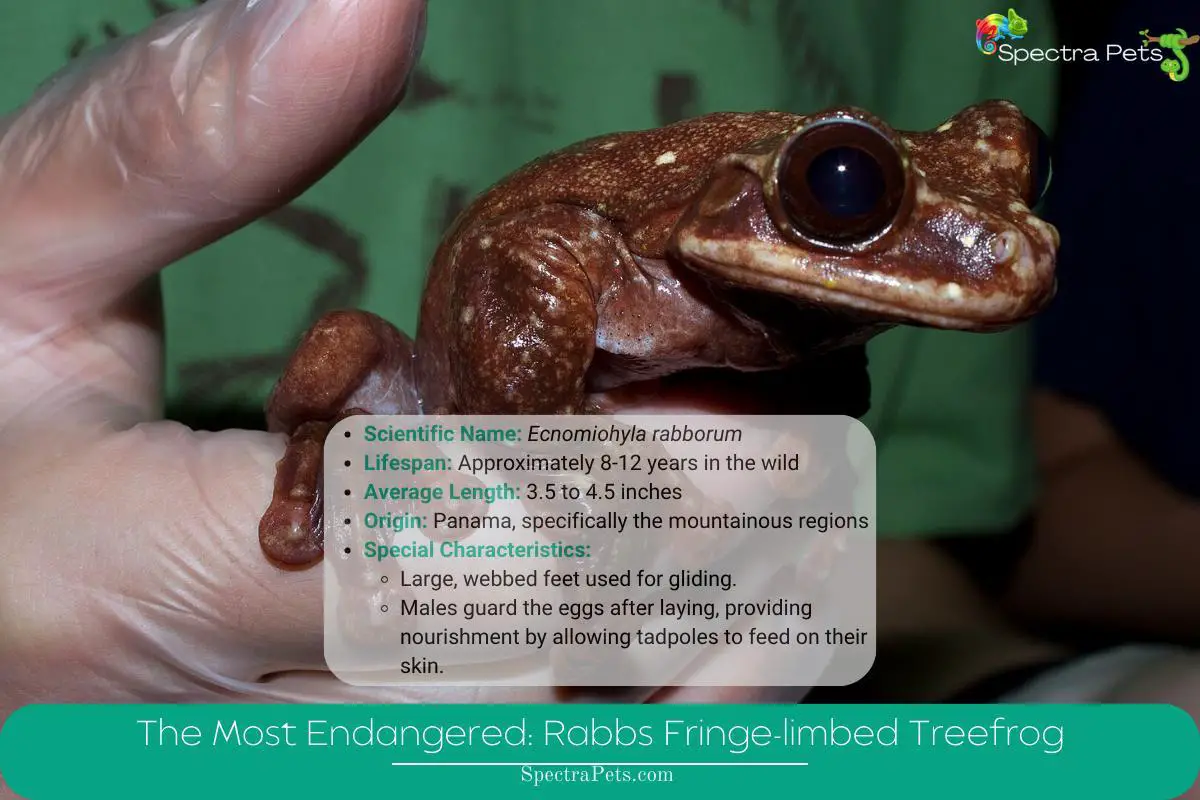
The Rabbs’ Fringe-limbed Treefrog suffered dramatic declines due to the spread of the deadly chytrid fungus, which has affected many amphibian species worldwide.
The last known individual, named “Toughie,” lived at the Atlanta Botanical Garden until its death in 2016. After Toughie’s death, it was feared that the species might be extinct in the wild, as no other individuals have been found despite extensive searching.
That said, nature is full of surprises, and species thought to be extinct have been rediscovered in the past. So, it’s always possible that there are some individuals remaining in the wild, but their chances are slim given the challenges they face.
It’s worth noting that many frog species worldwide are under threat, primarily due to habitat loss, climate change, and diseases like the chytrid fungus. The story of the Rabbs’ Fringe-limbed Treefrog serves as a stark reminder of the importance of conservation efforts for amphibians and all wildlife.
3. Archey’s Frog: Evolution’s Relic
In the cool, damp forests of New Zealand’s Coromandel Peninsula, you’ll find a relic from a bygone era—Archey’s frog. This species is often referred to as the world’s most evolutionarily distinct and globally endangered amphibian.
Species Profile:
- Scientific Name: Leiopelma archeyi
- Lifespan: Approximately 10-15 years
- Average Length: 1.5 to 2 inches
- Origin: New Zealand, primarily the Coromandel Peninsula and Whareorino Forest.
- Special Characteristics:
- It retains many primitive amphibian features.
- No external eardrums and lack of webbing between toes.
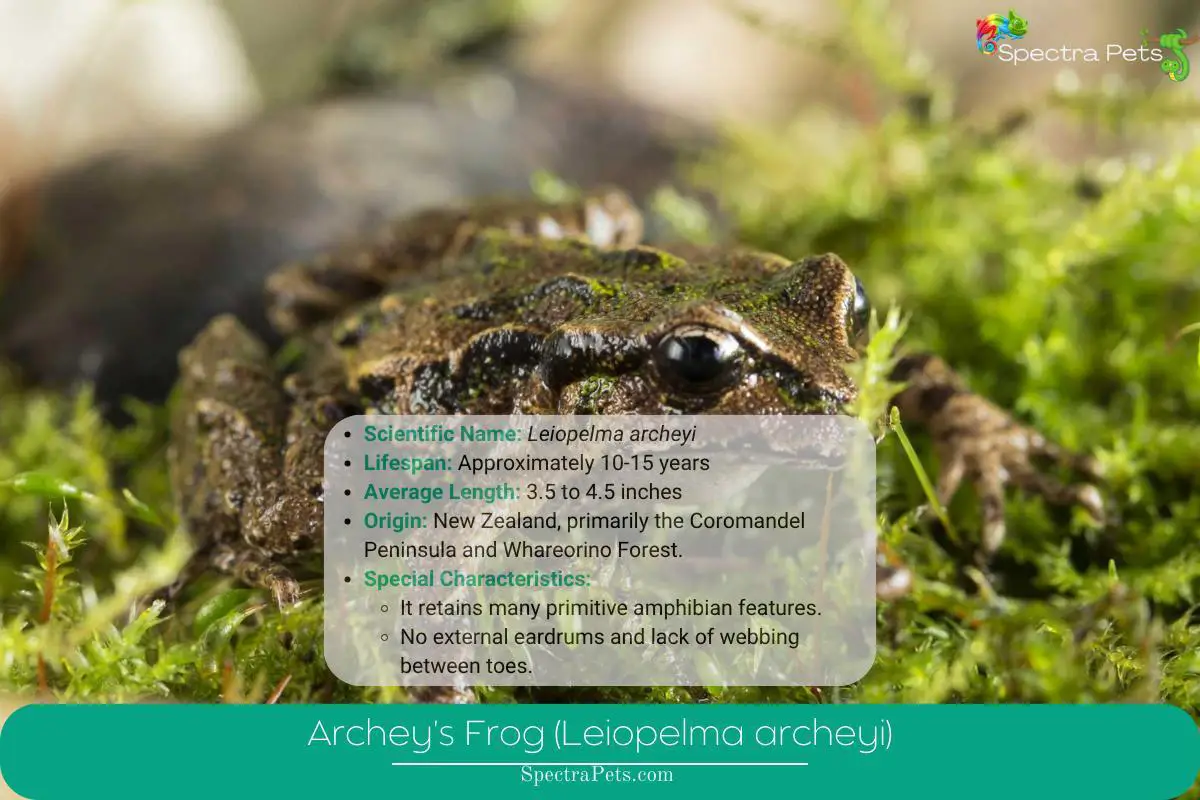
This diminutive creature, barely larger than a human thumb, holds secrets that can transport scientists millions of years back in time. Unlike many of its modern counterparts, Archey’s frog births nearly fully formed froglets, bypassing the tadpole stage entirely. This, along with its other ‘primitive’ features like the absence of external eardrums, has earned it the title of the world’s most ‘archaic’ frog. It is considered a “living fossil”!
Archey’s frogs are small, measuring up to about 37 mm in length. They have a distinct appearance, with warty skin and varied patterns in shades of brown and orange. Archey’s frogs are terrestrial and nocturnal. They can be found in moist forests, typically at higher altitudes.
But this living piece of history faces challenges. Its habitats are shrinking due to logging, and predatory rats, introduced by human settlers, have developed a taste for these small frogs. Additionally, the pervasive chytrid fungus threatens to wipe out entire populations.
New Zealand’s conservationists are working tirelessly to turn the tide. As Professor Liam Mitchell, a leading expert in amphibians, aptly puts it, “By protecting Archey’s frog, we’re not just saving a species but preserving a living chapter from Earth’s vast evolutionary tome.”
4. La Loma Treefrog: Rediscovered Wonder
La Loma Treefrog inhabits the rainforests of Colombia, primarily within the Chocó Department. For years, it was believed to be lost to science and nature. However, nature had other plans.
Species Profile:
- Scientific Name: Hyloscirtus colymba
- Lifespan: Estimated 6-10 years in the wild
- Average Length: 2 to 3 inches
- Origin: Colombia, primarily in the Chocó department
- Special Characteristics:
- Dark-green or Olive-green skin with yellow spots
- Excellent climbers due to their large, adhesive toe discs
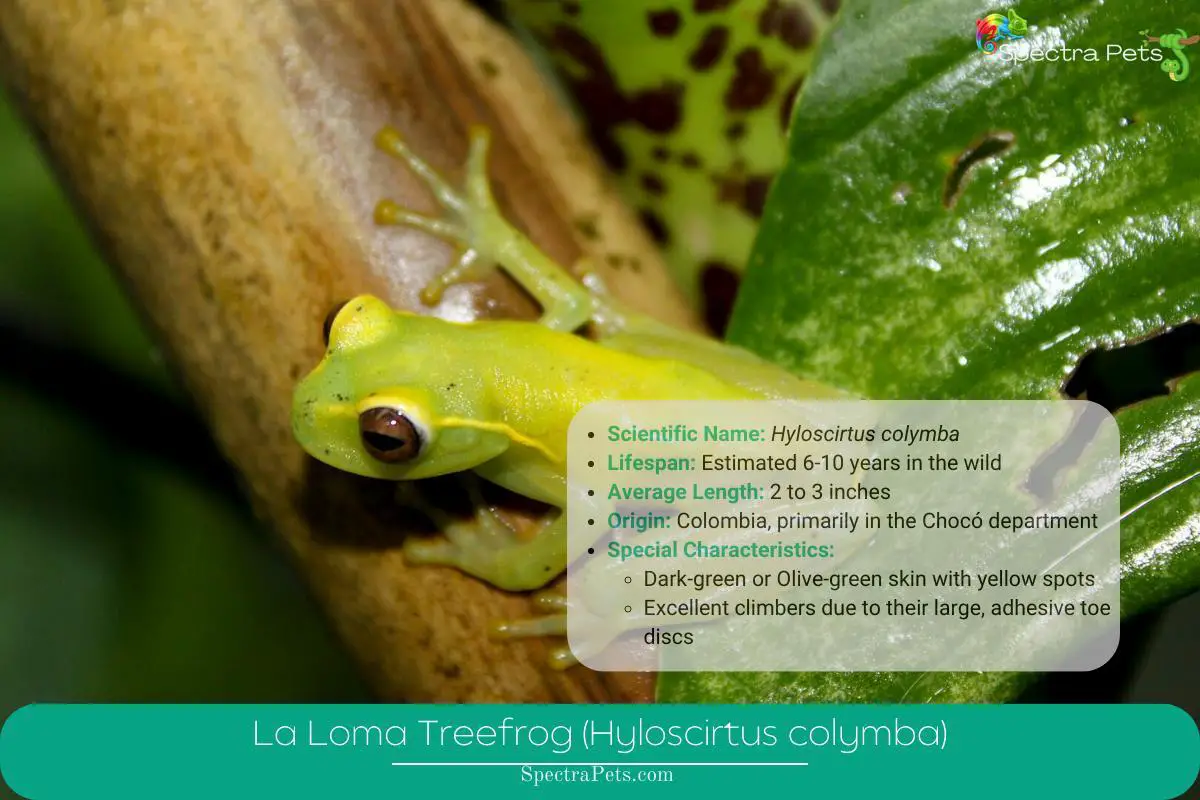
Once described as the “Ghost of the Rainforest”, the La Loma Treefrog remained elusive for nearly two decades. The extensive deforestation in Colombia’s Chocó region, one of the most biodiverse places on earth, led many experts to fear the worst. But in the late 2010s, a glimmer of hope arose when a small population was spotted in a secluded patch of rainforest. This discovery reinforced the need for conservation efforts in the area.
Its vibrant dark green skin, adorned with yellow spots, paints a beautiful contrast against the leafy canopy. Their large, adhesive toe discs make them exceptional climbers, navigating the heights with an enviable agility. But as with many marvels of nature, their existence faces threats—primarily from habitat destruction due to illegal logging and agriculture.
Did you know that the La Loma Treefrog‘s skin secretions are being studied for potential medicinal properties? Preliminary research suggests that certain compounds might be useful in fighting bacterial infections. The frog, with its olive-green skin and distinctive yellowish spots, doesn’t just add aesthetic value to its habitat but might also hold secrets to medical advancements.
5. The Purple Frog: India’s Subterranean Secret
The Western Ghats of India is not just a UNESCO World Heritage site but also home to one of the world’s most unique amphibians: The Purple Frog.
Species Profile:
- Scientific Name: Nasikabatrachus sahyadrensis
- Lifespan: Estimated 5-8 years
- Average Length: 2.7 to 3.1 inches
- Origin: Western Ghats of India
- Special Characteristics:
- Bloated body with a small head
- Spends most of its life underground
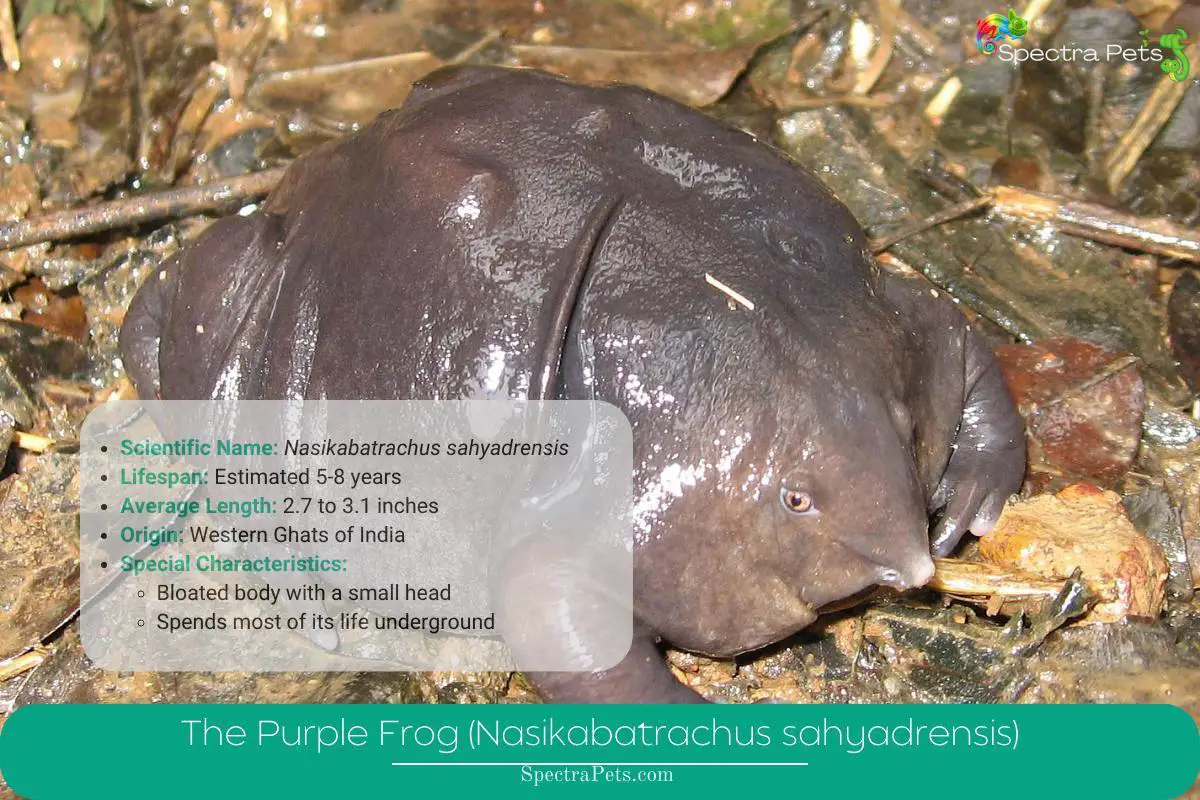
Named for its distinct color, the Purple Frog spends most of its life underground, emerging only during the monsoon season for mating. It’s not just the frog’s appearance that’s fascinating but also its evolutionary history. DNA analysis reveals that the species split from its closest relatives over 130 million years ago, making it a true living fossil.
One of the most intriguing aspects of the Purple Frog is its unique vocalization. Unlike its other amphibian counterparts, the mating call of the Purple Frog is a series of long ‘pulsed calls’, often mistaken for the sounds of chickens by the locals. Furthermore, its diet largely comprises termites, and it uses its specialized snout to dig and feast on them.
In 2018, a report in The Journal of Zoology highlighted that less than 200 mature individuals of this species might be left in the wild. The rapid urbanization of India’s Western Ghats and the resulting habitat loss poses a significant threat to this subterranean marvel. The Purple Frog stands as a testament to nature’s eccentricities, showcasing the wonders that lie beneath our very feet.
6. Hula Painted Frog: Israel’s Survivor
In the heart of the Middle East, Israel’s wetlands once echoed with the distinctive croaks of the Hula Painted Frog. This amphibian tells a tale of disappearance, rediscovery, and hope.
Species Profile:
- Scientific Name: Latonia nigriventer
- Lifespan: Estimated 7-12 years
- Average Length: 1.5 to 2.5 inches
- Origin: Israel’s Hula Valley
- Special Characteristics:
- Black belly with white speckles
- Elusive nature, rarely seen
- Thickset body with relatively short limbs
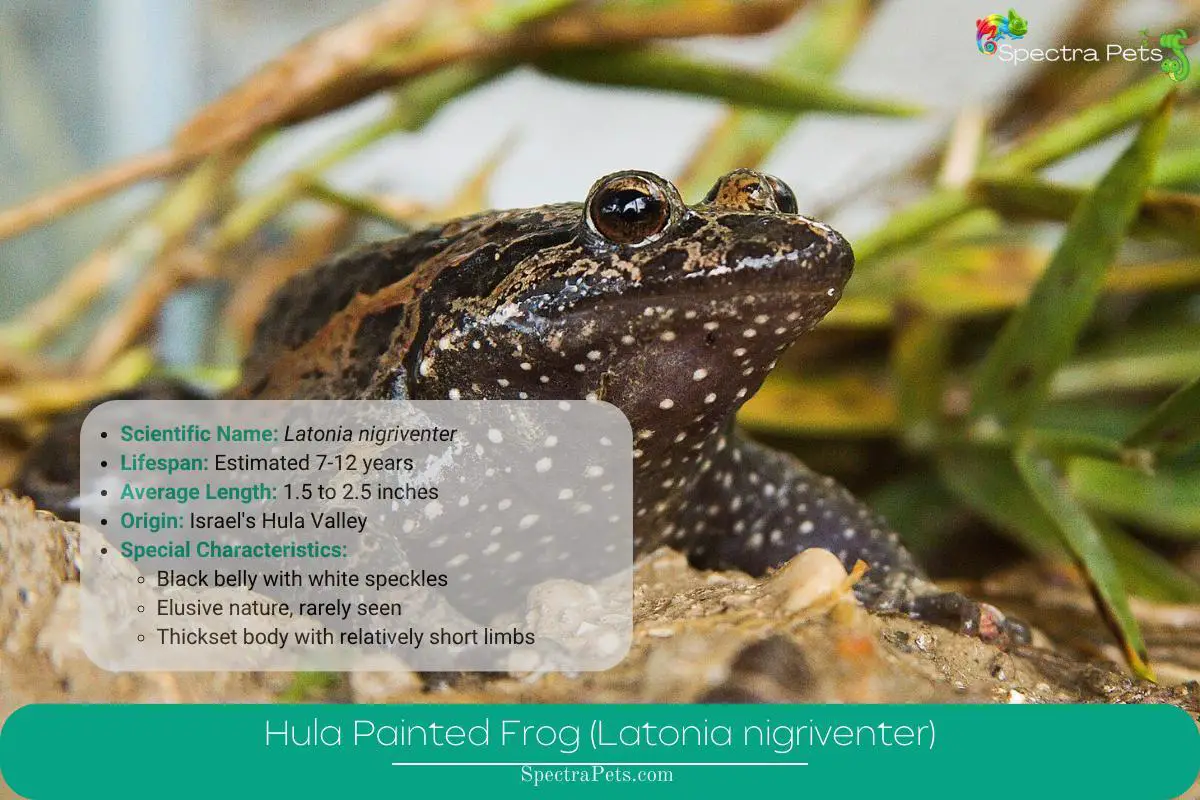
The Hula Painted Frog was believed to have become extinct in the 1950s, with the drainage of the Hula Valley. For six decades, this species was but a memory until a remarkable rediscovery in 2011, catapulting it back into scientific literature.
This frog holds a unique position in the ecosystem. Its diet consists of small invertebrates, and it, in turn, serves as food for birds and snakes. The frog’s distinctive dark belly with white spots isn’t just for show. Some experts believe it’s a type of mimicry to deter potential predators by resembling the venomous markings of other creatures.
An interesting revelation about the Hula Painted Frog is its close relation to fossils from the Miocene period, suggesting that the species might have existed for over 15 million years.
Conservationists are now working fervently to restore the Hula Valley’s ecosystem. The Hula Painted Frog, once a symbol of loss, now represents hope and the miracles of nature’s resilience.
7. Table Mountain Ghost Frog: South Africa’s Mountain Gem
Perched atop Cape Town’s iconic Table Mountain, this amphibian remains a treasure, as elusive as a specter, yet absolutely real.
Species Profile:
- Scientific Name: Heleophryne rosei
- Lifespan: Estimated 8-14 years
- Average Length: 2 to 2.5 inches
- Origin: Table Mountain in South Africa
- Special Characteristics:
- Pale, almost translucent skin
- Webbed feet adapted to strong, rapid streams
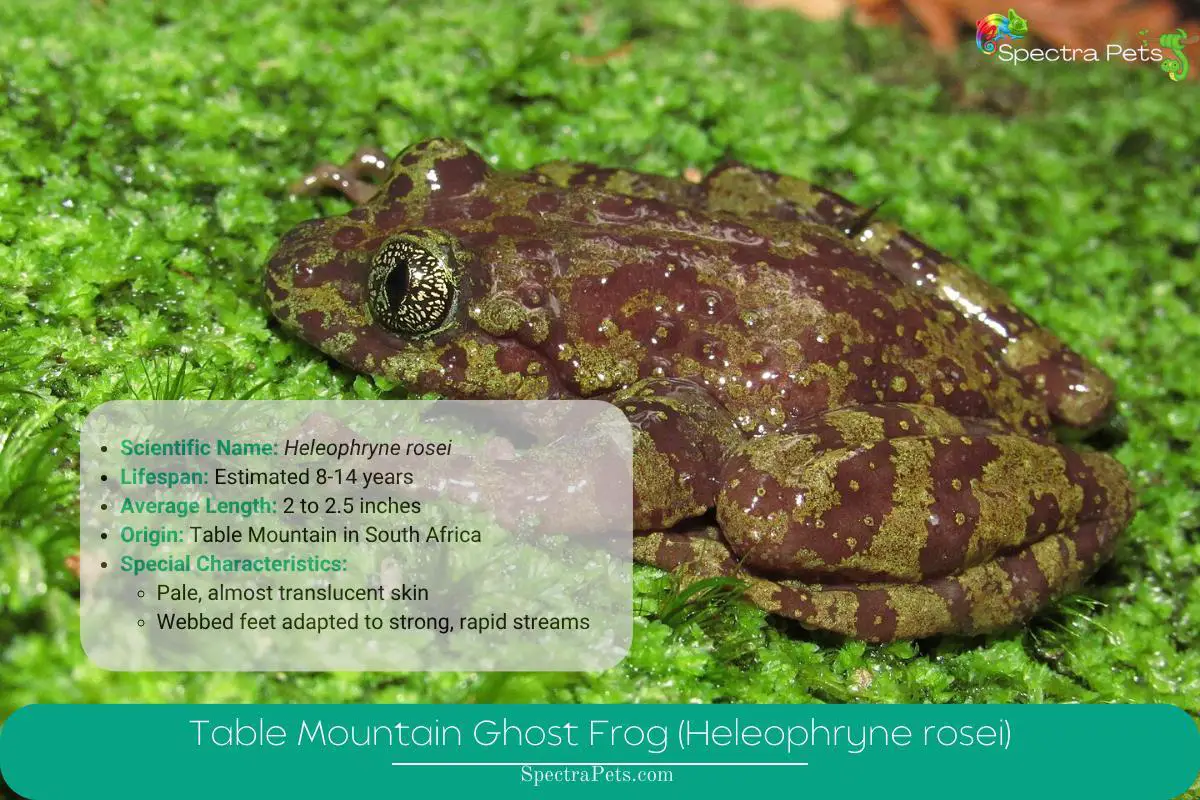
The Table Mountain Ghost Frog is endemic to a small section of Table Mountain, inhabiting the fast-moving streams and waterfalls. What sets this frog apart from others is its tadpoles. Unlike most, which have a few months of development, these tadpoles require a staggering two years before undergoing metamorphosis. This extended period is necessary for them to develop strong jaws, allowing them to hold onto rocks in rapid streams.
An astonishing fact about this frog is its evolutionary lineage. Studies suggest that its ancestors can be traced back to the early Mesozoic era, between 180-200 million years ago. This makes the Table Mountain Ghost Frog a relic from the time of the dinosaurs.
However, the modern world is closing in on this ancient being. The introduction of non-native plants and water extraction for Cape Town’s growing needs threatens its habitat. Moreover, with rising temperatures, the streams, which are its lifeline, are at risk of drying up.
Efforts by conservationists to protect this area and its unique resident have intensified in recent years. The Table Mountain Ghost Frog, a silent whisper of Earth’s ancient past, underscores the significance of preserving the delicate balance of our world.
8. Pebas Stubfoot Toad: Amazon’s Vulnerable Resident
Deep within the labyrinths of the Amazon rainforest resides an amphibian that captures the essence of the region’s biodiversity – the Pebas Stubfoot Toad.
Species Profile:
- Scientific Name: Atelopus spumarius
- Lifespan: Estimated 6-10 years
- Average Length: 1.6 to 2 inches
- Origin: Amazon Basin, spanning parts of Brazil, Colombia, and Peru
- Special Characteristics:
- Vibrant coloration ranging from greenish-yellow to deep black
- Rounded body with distinct stubby feet
- Pointed snout
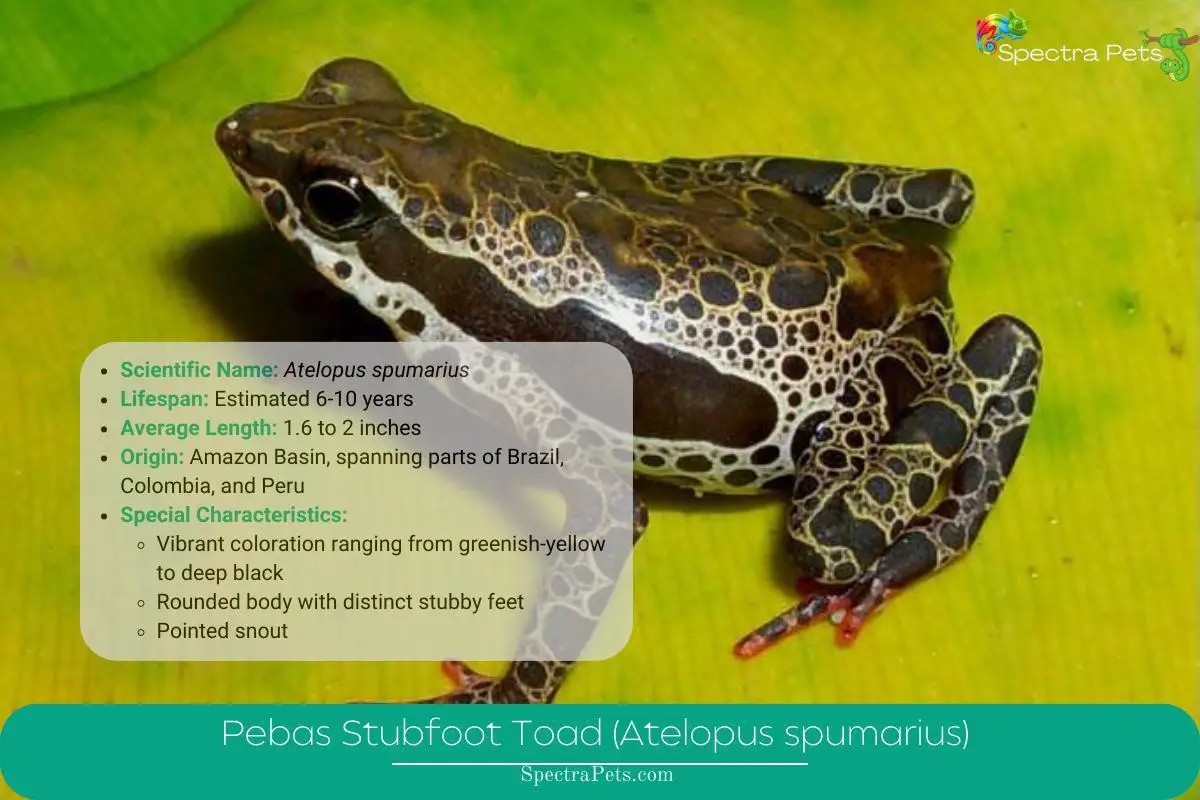
One of the most captivating aspects of the Pebas Stubfoot Toad is its adaptive coloration. While most individuals flaunt a bright hue, some are deep black with striking yellow spots. This color variance isn’t just a beauty aspect but an evolutionary tactic. It’s believed that their bright colors signal potential predators about their toxicity, a phenomenon known as aposematism.
The Amazon, with its vast ecosystem, is still a realm of many secrets. One intriguing find about the Pebas Stubfoot Toad comes from its diet. Recent observations noted these toads preying on spiders, a trait not common among its relatives.
Sadly, like many of its Amazonian peers, the Pebas Stubfoot Toad faces existential threats. Illegal logging, mining, and expanding agriculture are encroaching upon its habitat. Additionally, a fungal disease called chytridiomycosis has drastically affected its numbers.
With each Pebas Stubfoot Toad representing the beauty and vulnerability of the Amazon, efforts to safeguard them mirror the broader initiative to conserve this magnificent rainforest.
9. Philippine Flat-Headed Frog: Southeast Asian Enigma
Hidden among the streams and brooks of the Philippines lies an amphibian that challenges our understanding of adaptability – the Philippine Flat-headed Frog.
Species Profile:
- Scientific Name: Barbourula busuangensis
- Lifespan: Estimated 7-11 years
- Average Length: 2.5 to 3.2 inches
- Origin: Palawan in the Philippines
- Special Characteristics:
- Flattened head and body, perfect for its aquatic life
- Completely lungless, relying on skin for respiration
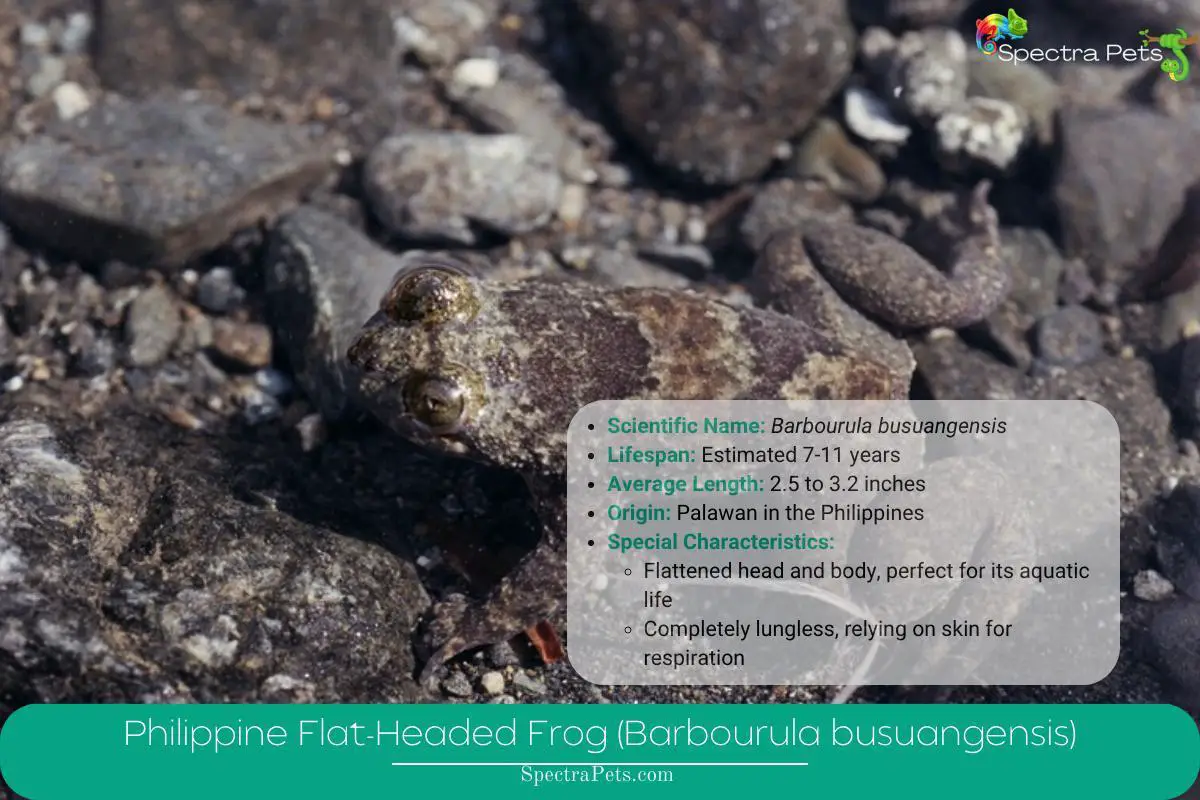
What makes the Philippine Flat-headed Frog genuinely remarkable is its lungless physiology. This frog is one of the only two known species in the world that has evolved to live without lungs, relying entirely on its skin to extract oxygen from the water. The other species without lungs, is its close relative, the Bornean Flat-headed Frog (Barbourula kalimantanensis). This adaptation allows it to stay submerged indefinitely, making it a perfect aquatic predator.
These frogs are, without doubt, the kings of their aquatic realm. They prey primarily on crustaceans, using their strong, muscular legs to pounce on unsuspecting victims. Their flattened morphology aids them in navigating the rapid streams, making them swift and elusive hunters.
However, the enchanting world of the Philippine Flat-headed Frog is under siege. Deforestation and the conversion of its habitat for agriculture have led to alarming declines in its population. Additionally, the increasing pollution in its freshwater habitats threatens its unique respiration method.
With the Philippine Flat-headed Frog embodying the mysteries and wonders of evolution, it serves as a beacon, reminding us of the myriad secrets that nature holds and the paramount importance of its preservation.
10. Sumatra Toad: Indonesia’s Cryptic Amphibian
Dwelling in the dense tropical rainforests of Sumatra, Indonesia, lies an amphibian that encapsulates the enigmatic beauty and mystery of Southeast Asian wildlife – the Sumatra Toad.
Species Profile:
- Scientific Name: Leptophryne cruentata
- Lifespan: Estimated 6-12 years
- Average Length: 1.6 to 2.4 inches
- Origin: Sumatra, Indonesia
- Special Characteristics:
- Rough, warty skin with distinctive coloration
- Enlarged parotoid glands behind the eyes
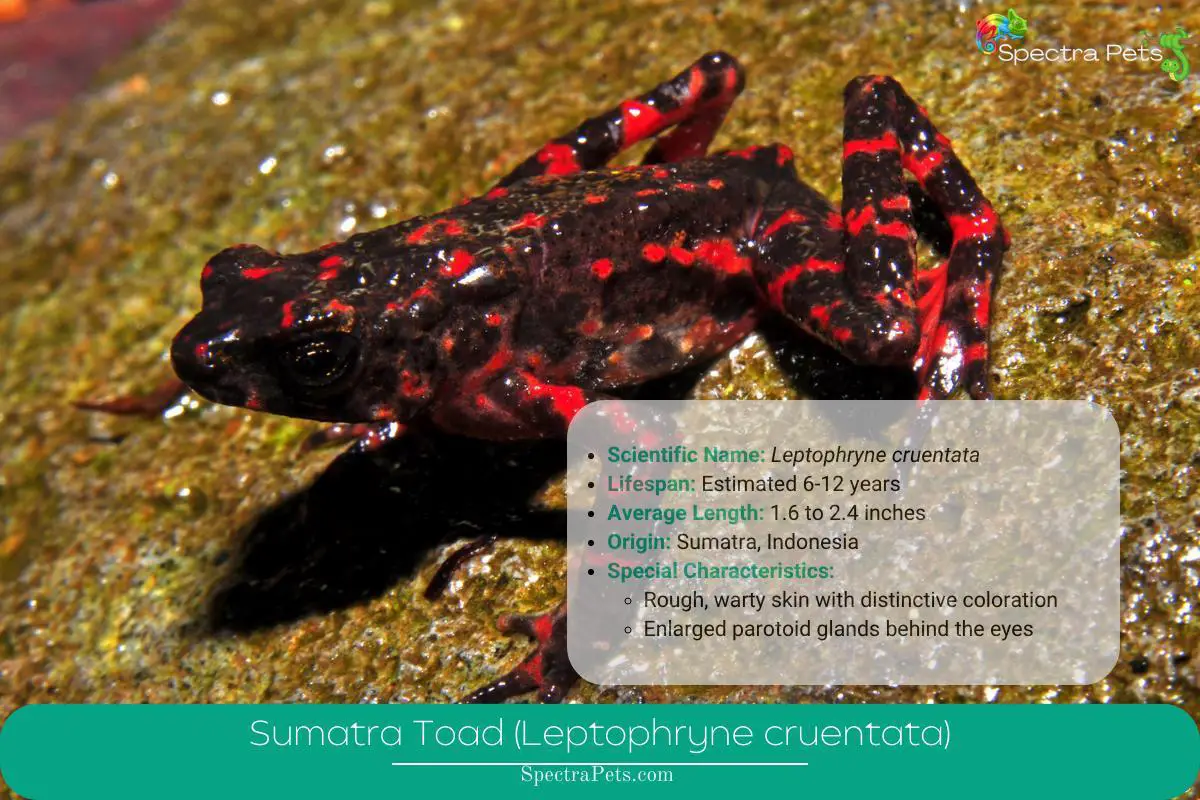
The Sumatra Toad’s textured skin, dappled in an array of dark hues and patterns, provides an optimal camouflage against the leaf litter and forest floor. This evolutionary asset ensures that it can stealthily navigate its habitat, avoiding the prying eyes of predators.
An astonishing facet of the Sumatra Toad’s biology is its breeding strategy. Female toads produce a clutch of eggs, attaching them to the underside of leaves above small water sources. Once hatched, the tadpoles drop directly into the water below, beginning their life in a semi-aquatic environment. This method ensures a high survival rate for the young, protecting them from a plethora of aquatic predators that would otherwise be a threat.
The toad’s call, a distinctive series of croaks, reverberates throughout the Sumatran rainforest, particularly during the breeding season. Local communities have noted that the presence of the Sumatra Toad’s call often indicates a nearby water source.
However, not everything is rosy for the Sumatra Toad. Rapid deforestation, driven by palm oil cultivation and logging, is dramatically reducing its habitat. Climate change further compounds these threats, altering the delicate ecological balance of its native environment.
Recent surveys in parts of Sumatra have found decreasing numbers of the toad. Alarmingly, in some localities where the toad was once prevalent, no individuals have been observed. Conservationists are now advocating for immediate measures to study and protect the Sumatra Toad, a true emblem of the region’s biodiversity.
Read Also: Oregon Spotted Frog Conservation Challenge
My Two Cents At The End
Throughout the world, the delicate symphony of amphibian life faces disruptions and dangers. From the dense Amazon to the serene landscapes of Southeast Asia, each rare frog and toad holds a unique tale of evolution, adaptability, and resilience. Their existence is not just a testament to nature’s grandeur but also a stark reminder of the fragility of ecosystems under human influence.
As we’ve journeyed through the stories of these extraordinary amphibians, it becomes clear that they’re not merely species awaiting salvation but crucial sentinels signaling the health of our planet. To ensure that their melodious calls continue to resonate in the wild, we must tread more thoughtfully, championing conservation and reverence for the incredible biodiversity that enriches our Earth.
